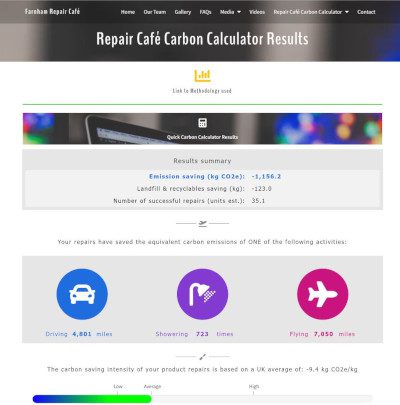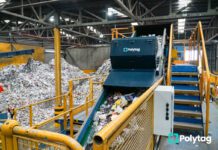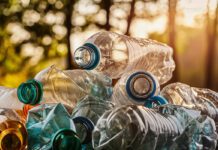
The latest version of a free online resource for repair cafés – the Repair Café Carbon Calculator from Farnham Repair Café (FRC) – went live on 13 April.
The group says the upgrade complements “right to repair” laws and associated trends. In March 2021, the first-ever right to repair laws came into effect in the EU, with the UK following four months later. Manufacturers in Europe are now legally obligated to ensure that electric and electronic goods, such as televisions and fridges, can be repaired for up to 10 years after purchase. On March 30th 2022 the EC launched its Sustainable Product Initiative (SPI), to ensure that products in the EU market are designed to be repairable, recyclable, durable, energy-efficient and free of hazardous chemicals.
“Repair Café Carbon Calculator V2 displays information on users’ carbon savings in a more easily and clearly understood way,” says its developer Steve Privett, a former FRC trustee and repairer, and currently a consultant and researcher.
“The new version will help repair cafés and other organisations to further realise and promote the benefits of repairing a product,” said FRC’s founder Professor Martin Charter.
“Repairing is a vital way of preventing waste, reducing CO2 emissions and combatting the ‘buy now, throw-away-later’ culture.”
Privett says, “There are no changes to how the tool operates or the calculation methods used. But, inside, the software has been re-engineered to display results through graphic images – and give a more descriptive equivalence to carbon savings via an example range of ‘everyday’ activities such as driving, air travel and hot showering. For example, 35 kg of repaired electrical items at a repair café session would save 306 kg of carbon emissions, the equivalent emissions of taking 191 hot showers.”
Emphasising that the new version makes it easier for organisers and users of repair cafés to understand and communicate environmental benefits to the public, he adds, “For example, a repair café keeping a record of the calculator’s results could say, “Since opening, we have saved the equivalent carbon emissions of someone flying 235,000 miles or driving a new petrol car more than 160,000 miles.”
Also new is a graph showing a percentage breakdown of the carbon emission savings contribution from each product repair category. It helps users quickly see how different repair categories contribute to the overall carbon emission savings, and how or where savings might be improved.
Additionally, the calculator features a graph showing the carbon emission savings intensity of repairs. This helps users to see if their repair café results or sessions are above or below the UK average calculated from original research data. Says Privett, “When more products – that created high carbon emissions when they were originally manufactured – are repaired, the carbon intensity of repairs moves to a higher level, and vice versa for products that created low carbon emissions during manufacture and transportation.”

Quick carbon calculator option
Users not requiring a comprehensive view of results via the standard calculator model can use the “quick” option. It allows users to rapidly estimate their carbon emission savings of a repair by entering either the total weight of successful repairs or the total number of items repaired successfully.
The option takes into account other factors that impact carbon emission emissions savings, including how many products are taken by the average visitor for repair and how many miles they will have driven to and from the repair café or other repair organisation.
The original version of the Repair Café Carbon Calculator was launched in 2020 and was the result of a three-month-long collaboration between Steve Privett and Professor Charter. Funding came from University for the Creative Arts UCA, following an award from the Strategic Priorities Fund from Research England. The group says the calculator was ground-breaking internationally and replaced guesswork and paper-based methods, and believes the calculator is still the only repair café carbon calculator of its kind.
User comments about the original version
“It’s very user friendly; very easy to enter items by weight and category; and the results summary is very useful” – Emilia Barnett, Alton Repair Café.
“We have used the calculator to work out the amount of carbon equivalent saved for items repaired. Consequently, it has been, and will be used, for a variety of items – electrical, other household, material, tools, bicycles etc. The strengths of the calculator are that it is easy to understand and gives a consistent approach to working out carbon saved” – Laura Harley, Overton Repair Café.
About FRC
FRC is open on every second Saturday of the month between 10am – 12.30pm and offers advice and repairs on all kinds of products, from vacuum cleaners, headphones and lights, to hats, jackets, pushchairs and bicycles. Address: FRC, The Spire Church, South Street, Farnham, GU9 7QU.
Founded in 2015, FRC became a UK-registered repair café charity in 2017, working in collaboration between The Centre for Sustainable Design ® at University of the Creative Arts, Farnham Town Council and The Spire Church in Farnham UK. FRC is part of the global Repair Café movement of 2283 (as of March 2022), led by The Repair Café International Foundation – founded in the Netherlands in 2011.
You can read more about FRC here.





